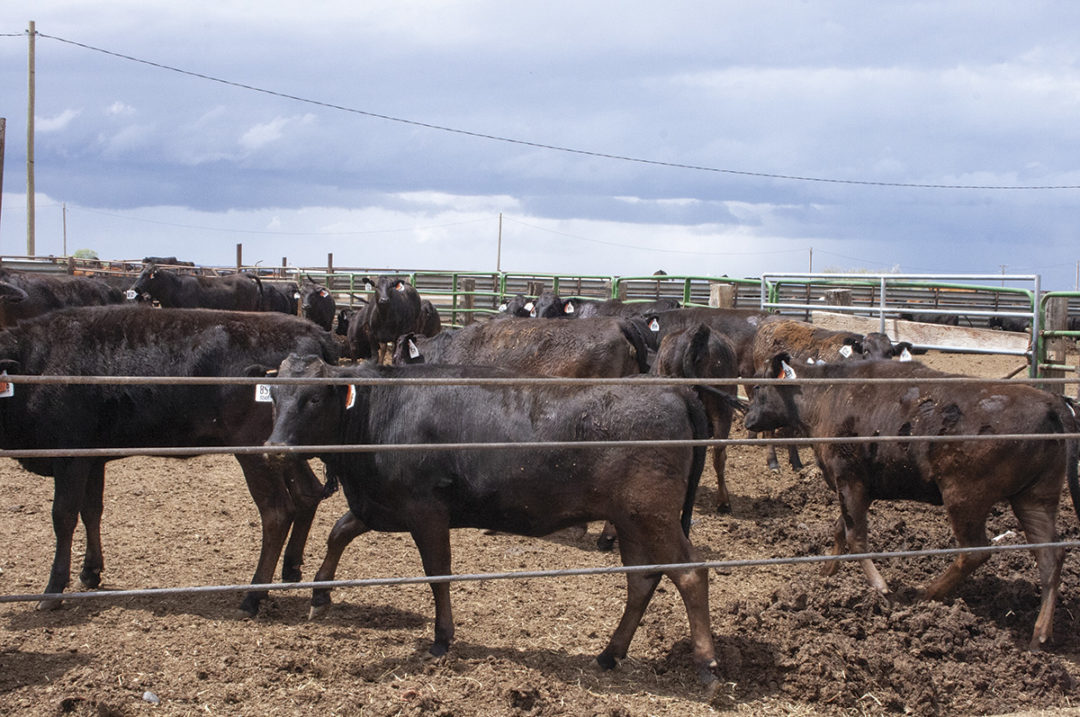Travis Lutz, with his wife, Pam; and father, Jim, has been working on his family farm and ranch for more than 40 years. He is a fourth-generation owner of the operation in Dundy County, Nebraska, tucked in the corner of the state near the Kansas and Colorado borders. With 1,100 to 1,200 calves per year and a 3,000-head feedlot, it is safe to say that he has seen and experienced a lot of challenges. So in 2018, when they began to face an additional 3% to 5% deaths on top of their normal losses, it was clear that something was wrong.
The Lutz feedlot is primarily Angus, with a few reds, Charolais and crosses. With most of their animals going direct sale to Cargill, and an increasing number of farm-to-table and retail cuts, reputation in the industry means everything. After a number of days on feed, the affected animals would begin to show signs of illness. The animals were treated like respiratory disease, but there was no recovery; death would occur within 10 to 14 days later. While the exact cause of death was unknown, this was just the beginning of a more widespread issue that was being observed and studied nearby.
Just down the road in Clay Center, Nebraska, Dr. Brian Vander Ley had been made aware of the disease just two years earlier when he began working at the University of Nebraska Great Plains Veterinary Education Center (GPVEC). Vander Ley is a veterinary epidemiologist who now has more than 15 years of experience in the field. His supervisor and former director of GPVEC, Dr. Dale Grotelueschen, began to observe the disease and an increased number of cardiac-related deaths at their Scottsbluff diagnostic laboratory. Grotelueschen recognized the research opportunity and tasked Vander Ley to work with Dr. Mike Heaton from the adjacent USDA Meat Animal Research Center (USMARC). Since 2016, this has been one of the primary focuses of their work.
Vander Ley and Heaton began collecting case samples from feedlots and designed a matched case-control study. In 2018, they hosted a workshop to describe bovine congestive heart failure, or BCHF, and to gather support for the research. In the executive summary from the meeting, they described the problem as “an untreatable, fatal condition involving pulmonary hypertension that culminates in right ventricular failure.” Although there have been case reports dating back to the 1970s and descriptions of brisket disease, high-altitude sickness and pulmonary hypertension, BCHF was a specific cause of heart failure that needed attention.
Meanwhile, back in Dundy County, the Lutzes' problem continued to grow. Treatments were ineffective, the cause was unknown, and they began to feel like they were getting the runaround. In spring of 2023, three postmortem samples were sent to Dr. Greta Krafsur, a veterinarian with Production Animal Consultants (PAC), for necropsy. She specialized in heart failure and was studying the correlation with pulmonary hypertension and elevation. Krafsur recognized the signs of BCHF and was aware that Vander Ley and Heaton had recently published the results of their case study, which led to the development of a genetic test predicting the risk level for developing the disease.
According to Vander Ley, there are a lot of misconceptions about the disease. “BCHF is not just a late-fed cattle problem,” Vander Ley says. “Even pre-weaning calves have heart failure problems. And just because cattle are high-performance doesn't mean they will have heart failure risk.”
There are also a number of classification errors and other causes of heart failure, because “BCHF is a general term that describes a very specific kind of heart failure,” Vander Ley says.
In its simplest form, the genetic test for BCHF targets the ARRDC3 and NFIA genes, and individuals with the high-risk genotype are 28 times more likely to develop the disease than a low-risk genotype. And unlike other forms of testing, the genetic test is relatively non-invasive, can be performed at birth to determine future risk and can be used to develop a breeding plan to reduce or eliminate the high-risk genotypes. Additionally, a new gene target (called Jumonji) was recently identified that protects against BCHF, with just a single copy of the minor allele needed.
In the summer of 2023, Lutz tested his bulls to determine which carried the high-risk genotype and is now beginning to test their replacement heifers. Their breeding plan is to eventually replace all of the high-risk bulls, but for now will match them with only low-risk heifers to breed out the problem. Similar to previous genetic defects, Lutz would like to see the bull breeders perform testing before the sale. Unlike those genetic defects, where the calf is born dead or severely deformed, with BCHF it can be a 1,000- to 1,100-pound animal that is affected, and a lot more money has been invested at that point.
Two or more clinical signs specific for BCHF must be present, and cardiomegaly alone is not diagnostic or predictive for the disease. “If BCHF is suspected as the cause of death,” Vander Ley says, “a good necropsy is very important. A diagnosis of BCHF requires ruling out other causes.”
However, the predictive value of the genetic test is equally important for breeding decisions. By removing the high-risk genotypes, early results indicate you could eliminate 30% of all heart failure. This begins with awareness, use of the tools and information that is available and management. The 2018 workshop summary concludes that “for some producers, it is the single most costly health-related problem … even surpassing those from bovine respiratory disease. Consequently, reducing the impact of BCHF is a high priority for the cattle industry.”
For more information about BCHF disease and risk, you can visit the USMARC website or contact Vander Ley by email.











